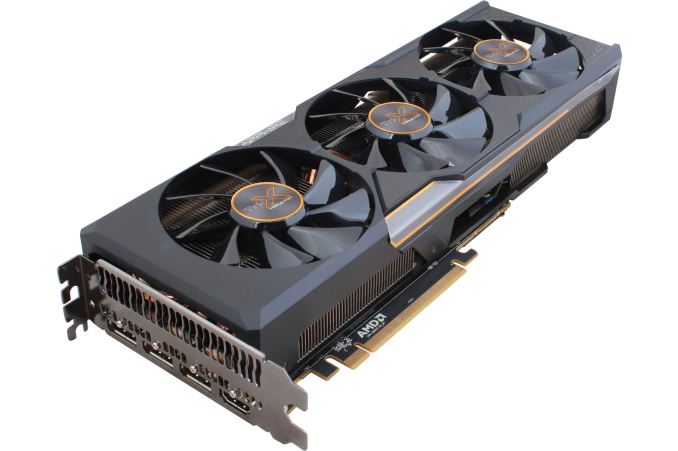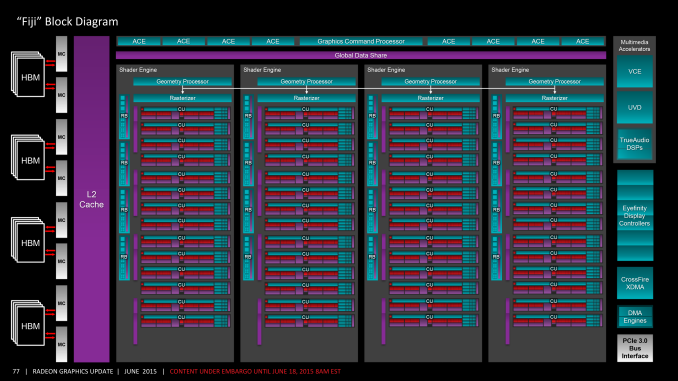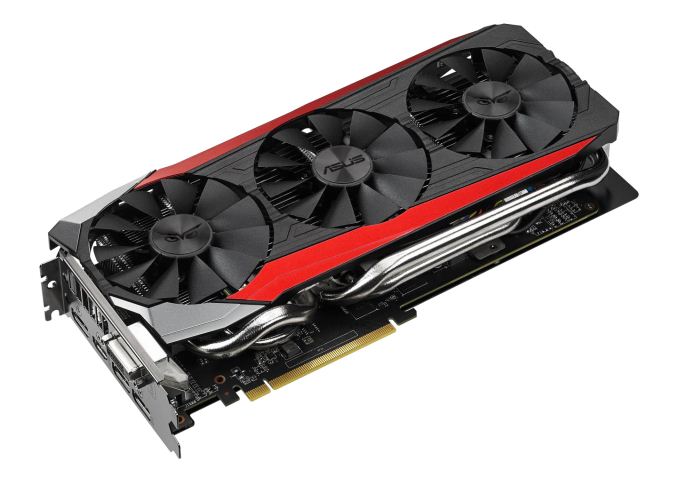The AMD Radeon R9 Fury Review, Feat. Sapphire & ASUS
by Ryan Smith on July 10, 2015 9:00 AM EST
A bit over two weeks ago AMD launched their new flagship video card, the Radeon R9 Fury X. Based on the company’s new Fiji GPU, the R9 Fury X brought with it significant performance improvements to AMD’s lineup, with AMD’s massive Fiji greatly increasing the card’s shading resources. Meanwhile Fiji also marked the introduction of High Bandwidth Memory (HBM) in to consumer products, giving the R9 Fury X a significant leg up in memory bandwidth. Overall AMD put together a very impressive card, however at $649 it fell just short of the GeForce GTX 980 Ti AMD needed it to beat.
Meanwhile alongside the announcement of the R9 Fury X, AMD announced that there would be three other Fiji-based cards. These include the R9 Fury, the R9 Nano, and a yet-to-be-named dual-GPU Fiji card. The first of these remaining cards to launch would be the R9 Fury, the obligatory lower-tier sibling to AMD’s flagship R9 Fury X. Today we will be taking a look at the first of those remaining cards, the R9 Fury, which launches next week.
While R9 Fury X remains the fastest Fiji card – and by virtue of being introduced first, the groundbreaking card – the impending launch of the R9 Fury brings with it a whole slew of changes that make it an interesting card in its own right, and a very different take on a Fiji product altogether. From a performance standpoint it is a lower performing card, featuring a cut-down Fiji GPU, but at the same time it is $100 cheaper than the R9 Fury X. Meanwhile in terms of construction, unlike the R9 Fury X, which is only available in its reference closed loop liquid cooling design, the R9 Fury is available as semi-custom and fully-custom cards from AMD’s board partners, built using traditional air coolers, making this the first air cooled Fiji card. As a result the R9 Fury at times ends up being a very different take on Fiji, for all of the benefits and drawbacks that comes with.
| AMD GPU Specification Comparison | ||||||
| AMD Radeon R9 Fury X | AMD Radeon R9 Fury | AMD Radeon R9 290X | AMD Radeon R9 290 | |||
| Stream Processors | 4096 | 3584 | 2816 | 2560 | ||
| Texture Units | 256 | 224 | 176 | 160 | ||
| ROPs | 64 | 64 | 64 | 64 | ||
| Boost Clock | 1050MHz | 1000MHz | 1000MHz | 947MHz | ||
| Memory Clock | 1Gbps HBM | 1Gbps HBM | 5Gbps GDDR5 | 5Gbps GDDR5 | ||
| Memory Bus Width | 4096-bit | 4096-bit | 512-bit | 512-bit | ||
| VRAM | 4GB | 4GB | 4GB | 4GB | ||
| FP64 | 1/16 | 1/16 | 1/8 | 1/8 | ||
| TrueAudio | Y | Y | Y | Y | ||
| Transistor Count | 8.9B | 8.9B | 6.2B | 6.2B | ||
| Typical Board Power | 275W | 275W | 250W | 250W | ||
| Manufacturing Process | TSMC 28nm | TSMC 28nm | TSMC 28nm | TSMC 28nm | ||
| Architecture | GCN 1.2 | GCN 1.2 | GCN 1.1 | GCN 1.1 | ||
| GPU | Fiji | Fiji | Hawaii | Hawaii | ||
| Launch Date | 06/24/15 | 07/14/15 | 10/24/13 | 11/05/13 | ||
| Launch Price | $649 | $549 | $549 | $399 | ||
Starting things off, let’s take a look at the specifications of the R9 Fury. As we mentioned in our R9 Fury X review, we have known since the initial R9 Fury series launch that the R9 Fury utilizes a cut-down Fiji GPU, and we can now reveal just how it has been cut down. As is usually the case for these second-tier cards, the R9 Fury features both a GPU with some functional units disabled and a slightly reduced clockspeed, allowing AMD to recover partially defective GPUs while easing up on the clockspeed requirements.
The Fiji GPU in the R9 Fury ends up having 56 of 64 CUs enabled, which brings down the total stream processor count from 4,096 to 3,584. This in turn ends up being the full extent of the R9 Fury’s disabled functional units, as AMD has not touched the front-end or back-end, meaning the number of geometry units and the number of ROPs remained unchanged.
Also unchanged is the memory subsystem. All Fiji-based cards, including the R9 Fury, will be shipping with a fully enabled memory subsystem, meaning we’re looking at 4GB of HBM attached to the GPU over a 4096-bit memory bus. With Fiji topping out at just 4GB of memory in the first place – one of the drawbacks faced by the $650 R9 Fury X – cutting back on memory here to a smaller capacity is not a real option for AMD, so every Fiji card will come with that much memory.
As for clockspeeds, R9 Fury takes a slight trim on the GPU clockspeed. The reference clockspeed for the R9 Fury is a flat 1000MHz, a 5% reduction from the R9 Fury X. On the other hand the memory clock remains unchanged at 500MHz DDR, for an effective memory rate of 1Gbps/pin.
All told then, on paper the performance difference between the R9 Fury and R9 Fury X will stand to be between 0% and 17%; that is, the R9 Fury will be up to 17% slower than the R9 Fury X. In the best case scenario for the R9 Fury of a memory bandwidth bottleneck, it has the same 512GB/sec of memory bandwidth as the R9 Fury X. At the other end of the spectrum, in a shader-bound scenario, the combination of the reduction in shader hardware and clockspeeds is where the R9 Fury will be hit the hardest, as its total FP32 throughput drops from 8.6 TFLOPs to 7.17 TFLOPs. Finally in the middle, workloads that are front-end or back-end bound will see a much smaller drop since those units haven’t been cut-down at all, leading to just a 5% performance drop. As for the real world performance drop, as we’ll see it’s around 7%.
Power consumption on the other hand is going to be fairly similar to the R9 Fury X. AMD’s official Typical Board Power (TBP) for the R9 Fury is 275W, the same as its older sibling. Comparing the two products, the R9 Fury sees some improvement from the disabled CUs, however as a second-tier part it uses lower quality chips overall. Meanwhile the use of air cooling means that operating temperatures are higher than the R9 Fury X’s cool 65C, and as a result power loss from leakage is higher as well. At the end of the day this means that the R9 Fury is going to lose some power efficiency compared to the R9 Fury X, as any reduction in power consumption is going to be met with a larger decrease in performance.
Moving on, let’s talk about the cards themselves. With the R9 Fury X AMD has restricted vendors to selling the reference card, and we have been told it will be staying this way, just as it was for the R9 295X2. On the other hand for R9 Fury AMD has not even put together a complete reference design, leaving the final cards up to their partners. As a result next week’s launch will be a “virtual” launch, with all cards being semi or fully-custom.
Out of the gate the only partners launching cards are Sapphire and Asus, AMD’s closest and largest partners respectively. Sapphire will be releasing stock and overclocked SKUs based on a semi-custom design that couples the AMD reference PCB with Sapphire’s Tri-X cooler. Asus on the other hand has gone fully-custom right out of the gate, pairing up a new custom PCB with one of their DirectCU III coolers. Cards from additional partners will eventually hit the market, but not until later in the quarter.
The R9 Fury will be launching with an MSRP of $549, $100 below the R9 Fury X. This price puts the R9 Fury up against much different competition than its older sibling; instead of going up against NVIDIA’s GeForce GTX 980 Ti, the closest competition will be the older GeForce GTX 980. The official MSRP on that card is $499, so the R9 Fury is more expensive, but in turn AMD is promising better performance than the GTX 980. Otherwise NVIDIA’s partners serve to fill that $50 gap with their higher-end factory overclocked GTX 980 cards.
Finally, today’s reviews of the R9 Fury are coming slightly ahead of the launch of the card itself. As previously announced, the card goes on sale on Tuesday the 14th, however the embargo on the reviews is being lifted today. AMD has not officially commented on the launch supply, but once cards do go on sale, we’re expecting a repeat of the R9 Fury X launch, with limited quantities that will sell out within a day. After that, it seems likely that R9 Fury cards will remain in short supply for the time being, also similar to the R9 Fury X. R9 Fury X cards have come back in stock several times since the launch, but have sold out within an hour or so, and there’s currently no reason to expect anything different for R9 Fury cards.
| Summer 2015 GPU Pricing Comparison | |||||
| AMD | Price | NVIDIA | |||
| Radeon R9 Fury X | $649 | GeForce GTX 980 Ti | |||
| Radeon R9 Fury | $549 | ||||
| $499 | GeForce GTX 980 | ||||
| Radeon R9 390X | $429 | ||||
| Radeon R9 290X Radeon R9 390 |
$329 | GeForce GTX 970 | |||
| Radeon R9 290 | $250 | ||||
| Radeon R9 380 | $200 | GeForce GTX 960 | |||
| Radeon R7 370 Radeon R9 270 |
$150 | ||||
| $130 | GeForce GTX 750 Ti | ||||
| Radeon R7 360 | $110 | ||||












288 Comments
View All Comments
FlushedBubblyJock - Wednesday, July 15, 2015 - link
They can't even supply the dang cores properly, that's why you ONLY SEE SAPPHIRE.Hell you can't even buy them (furyx) at newegg.
So profit would require actual valid production instead of paperlaunched vape.
bill.rookard - Friday, July 10, 2015 - link
I'm betting that they can, but the problem is not the 980 which they could match, but as noted in the review, the Fury X. It's a similar issue with the 980ti vs Titan. The 980ti is 60% of the price, but 90+% of the performance. At that point, the ONLY reason to get a Titan is if you need it for FP64 compute.In this case, if they took it to the $500 price point, you'd be in the same boat. 75% of the price for 93% of the performance, and it would really cannibalize the Fury X. Keeping it at $550 makes it an 85% of the price for 93% performance. And, since it does outperform the 980, it should be a bit more expensive.
xenol - Friday, July 10, 2015 - link
Honestly though, I think AMD should be undercutting themselves a bit to win more of the market share. If I compare the GTX 980 and the R9 Fury, the only problem I see is I take a 10% or so cut to 1080p performance. If the R9 Fury is the same price, then I can forgive the higher power consumption in exchange for better performance at the same price point.I don't think a lot of people consider the top tier cards anyway (not including the Titan, which is ridiculous in and of itself for most consumers).
FlushedBubblyJock - Wednesday, July 15, 2015 - link
Most people are at 1080P, that's WHY NVIDIA optimizes for it.But, the fickle insanity of all the reviewers requires unplayable "compromises" on image quality and frame rates, and the stupid as dog doo fanboy base goes along for the autistic ride.
NVIDIA knows better, there are sane persons such as myself - when spending multiple hundreds on a video card I don't want to "cut doown on settings" and fiddle with the dang thing day and night then test for "playability".
I don't want to waste my life screwing around.
I game 980Ti at 1920x 1200 and it's BARELY ENOUGH to not worry about any settings I want to use, in any game whatsoever - which is of course the most enjoyable thing !
No crashing, no haggling, no constant attempts at optimizing, no cutting down eye candy, no limiting !
Now maybe for someone who wants to hassle with 2 or 3 or 4 cards, a gagggle of cables, likely custom water cooling, a monstruous noise constantly going, then a huge 3k or triplet monitors - then THEY STILL HAVE TO SHUT OFF EYE CANDY AND SETTINGS TO GET A DECENT PLAYABLE FRAME RATE.... THOUSANDS UPON THOUSANDS OF DOLLARS YET INADEQUATE.
Sorry, not this gamer. No way, not ever.
extide - Friday, July 10, 2015 - link
Except the Titan X has crappy FP64 compute, so even that isnt a reason.Hxx - Friday, July 10, 2015 - link
completely agree but value wise does not beat the 980 unfortunately which can be had for much less than $500 once you flip the crap batman game.Archie2085 - Friday, July 10, 2015 - link
Hey Ryan..Wondering how much the drop in power consumption is when setting the fan to max speed. Is lekage power significant when making the card run cooler say 65 degs or so? if it can be tested
Thanks
HighTech4US - Friday, July 10, 2015 - link
What a worthless review.You use the Reference GTX 980 and don't overclock it or even use one of the many many factory overclocked models available yet there in all your charts is the Sapphire Tri-X R9 Fury OC.
I thought the previous review was brown nosing AMD but this one even out does that one.
HighTech4US - Friday, July 10, 2015 - link
EVGA 04G-P4-2983-KR GeForce GTX 980 Superclocked ACX 2.0 4GB 256-Bit GDDR5 PCI Express 3.0 x16 SLI Support Video CardCore Clock: 1266MHz
Boost Clock: 1367MHz
Available today for $507.99 or 487.99 after $20 rebate card.
http://www.newegg.com/Product/Product.aspx?Item=N8...
K_Space - Friday, July 10, 2015 - link
Nonesense. I'm not sure what review you glossed over but this was a fantastic read. I'm oggling over the Sapphire's noise results, quite phenomenomal.RE: OC versus stock cards. This seem to be a ?policy ?protocol of many review sites and not just Anandtech. If you been on the site long enough you'd know it doesn't it apply to this review only: flick back to the 980 and 980Ti reviews you'll see the OC'd card under review tested against stock counterparts. It's not Anandtech either. Hexus does exactly the same (they OC'd the alraedy overclocked phenomenal 980 Ti G1 from Gigabyte versus stock models; it trashed the 295x2). It's annoying to keep flicking in between to check all the oc'd results but to bash the whole review is unfair to say the least.